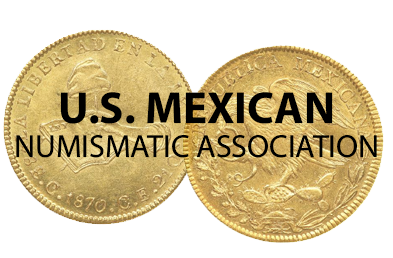Ten pesos coins (1905-1988)
Gold
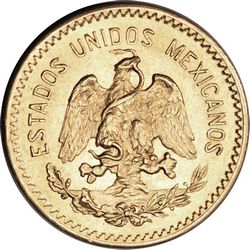
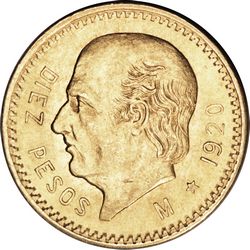
KM-473 1920 $10
These were composed of 90% gold and 10% copper. They had a weight of 8.333 g and diameter of 22.5 mm.
| Year | Mintage | |
| 1905 | 38,612 | |
| 1906 | 2,949,000 | 1 million pieces were produced by the Philadelphia mint. |
| 1907 | 1,589,000 | |
| 1908 | 890,000 | |
| 1910 | 451,000 | |
| 1916 | 26,000 | |
| 1917 | 1,966,500 | |
| 1919 | 266,000 | |
| 1920 | 22,603,000 | |
| 1959 Restrike | 964,983 |
Silver
The silver $10 coins were minted in six different types:
Type 1 - Hidalgo Grande
Type 2 - Constitution
Type 3- Hidalgo/Madero
Type 4 - Hidalgo, thin
Type 5 - Hidalgo, thick
Type 6 - Hidalgo, steel
Type 1 – Hidalgo Grande
On 13 September 1955 Adolfo Ruiz Cortines issued a decree giving the characteristics of new coins of 1c, 5c, 10c, 20c, 50c $1, $5 and $10Diario Oficial, 15 September 1955.
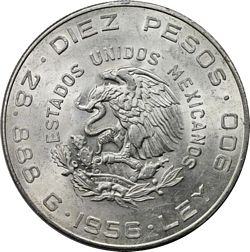
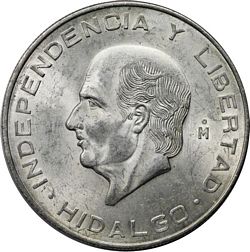
KM-474 1956 $1
So, due to the devaluation of a year earlier two new silver coins of five and ten pesos were introduced, both with the same design. This was composed of 90% silver, 10% copper, weighed 28.888 g and had a diameter of 40 mm.
Mintage was 584,500 in 1956 and 3,535,000 in 1956.
Type 2 – Constitution
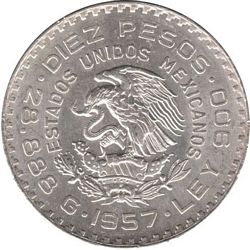
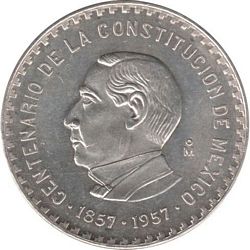
KM- 475 1857 $10
These coins, authorised on 31 December 1956 to commemorate the 1857 Constitution, had the same composition and size as the earlier $10 coins. Only 100,000 were minted in 1957.
Type 3 – Hidalgo/Madero
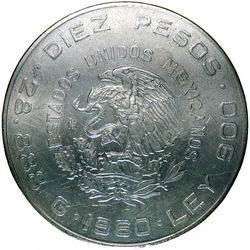
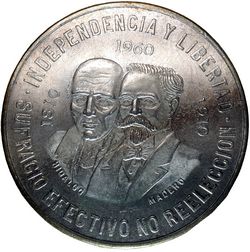
KM-476 1960 $10
These coins commemorate the 150th anniversary of the War for I dependence and the 50th anniversary of the beginning of the Revolution, had the same composition and size as the earlier $10 coins. 1,000,000 were minted in 1960.
Type 4 – Hidalgo, Thin
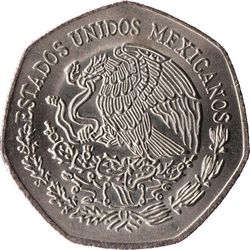
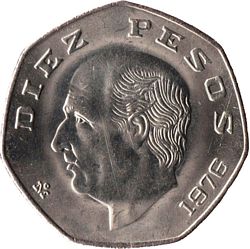
KM-477.1 1976 $10
These coins were authorised by a decree of 23 December 1973. They no longer have any silver content, being 75% copper and 25% nickel.
The story of this coin’s shape is that in 1973, the Mexican President and his cabinet traveled to Great Britain, and on that visit the authorities and officials related to the currency noticed the shape of the heptagonal shape of 50p coin and they took it as inspiration to mint something similar in Mexico. The Mint acquired two Taylor & Challen minting presses to make heptagonal coins very similar to the English ones. They have a heptagonal diameter of 30.4 mm and weigh 10 g. Mintage was
| Year | Mintage | |
| 1974 | 3,900,000 | |
| 1975 | 1,000,000 | |
| 1976 | 74,500,000 | open 6 |
| 1977 | 79,620,000 |
William Laurence Hanks wrote “despite the fact that the first year of minting was 1974 by the end of 1975 no copy of 1974 and 1975 had been put into circulation, although its production was already known. This caused a tremendous speculative activity regarding whether this coin would really see the light or be destroyed, it is said that three specimens managed to leave the mint and were sold for up to $800 US, knowing that it was a risk... and it was.”
Type 5 Hidalgo, Thick
KM-477.2
These were like Type 4 but minted on a thick flan and so weighed 14 g. It is believed that the change was due to two factors, the first to differentiate the Mexican currency from the English one, since the shape of both coins was identical. Another reason, according to José Manuel Sobrino, was due to the fact that the thickness of the flan and the diameter of the $10 coin (30.4 mm. / 10 gr.) were slightly equal to the dimensions of the $1 coin (29 mm. / 9 gr.) so there was a fear that the latter would be filed down.
| Year | Mintage | |
| 1978 | 124,850,000 | |
| 1979 | 57,200,000 | |
| 1980 | 55,200,000 | |
| 1981 | 222,767,990 | |
| 1982 | 151,770,000 | |
| 1985 | 58,000,000 |
Type 6 – Hidalgo, Steel
KM-512
These were authorised by a decree of 9 January 1986. These were produced in stainless steel, weigh 3.84g and have a diameter of 19mm.
| Year | Mintage | |
| 1985 | 257,000,000 | |
| 1986 | 392,000,000 | |
| 1987 | 305,000,000 | |
| 1988 | 500,300,000 | |
| 1898 | ||
| 1990 |
